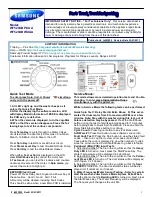
10 — English
OPERATION
To check lubricant level:
Set unit on a flat surface. Make sure engine is stopped
and unit has been allowed to cool.
Clean the area around the engine oil fill cap/dipstick to
keep dirt out of the engine.
Unscrew and remove oil fill cap/dipstick. Wipe dipstick
clean and re-seat in hole; do not re-thread.
Remove dipstick again and check lubricant level. Lubricant
level should come up to, but not over, the F or FULL mark
on the dipstick.
If level is low, add engine lubricant until the fluid level rises
to the F or FULL mark on the dipstick.
NOTE: Always check engine lubricant level before adding
additional lubricant.
Replace and secure the oil cap/dipstick.
CAUTION:
Do not overfill. Overfilling the crankcase may cause ex-
cessive smoke and engine damage.
NOTE: See the accompanying engine manual for more
information regarding engine lubricants.
OXYGENATED FUELS
DO NOT USE E85 FUEL. IT WILL VOID YOUR WAR-
RANTY.
NOTE: Fuel system damage or performance problems re-
sulting from the use of an oxygenated fuel containing more
than the percentages of oxygenates stated below
are not
covered under warranty.
Ethanol. Gasoline containing up to 10% ethanol by volume
(commonly referred to as E10) or 15% ethanol by volume
(commonly referred to as E15) are acceptable. E85 is not.
ADDING GASOLINE TO THE FUEL TANK
See Figure 9.
WARNING:
Gasoline and its vapors are highly flammable and
explosive. To prevent serious personal injury and prop-
erty damage, handle gasoline with care. Keep away from
ignition sources, handle outdoors only, do not smoke
while adding fuel, and wipe up spills immediately.
When adding gas to the pressure washer, make sure the unit
is sitting on a flat, level surface. If the engine is hot, let the
pressure washer cool before adding gas. ALWAYS fill the
fuel tank outdoors with the machine turned off.
NOTE: Use unleaded gas only. DO NOT mix lubricant with
gas.
Before removing the fuel cap, clean the area around it.
Remove the fuel cap.
Insert a clean funnel into the fuel tank then slowly
pour gasoline into the tank. Fill tank to approximately
1-1/2 in. below the top of the tank neck (this allows for
fuel expansion).
Replace fuel cap and tighten securely.
Clean up any spills before starting the engine.
PUMP LUBRICANT
The pressure washer pump has been filled with sufficient
lubricant at the factory. You do not need to check or add
lubricant to the pump before initial use.
STARTING AND STOPPING THE PRESSURE
WASHER
See Figures 10 - 11.
CAUTION:
Do not run the pump without the water supply connected
and turned on.
Before starting the engine:
Connect all hoses.
Check all fluids (lubricant and gas).
Turn on the garden hose then squeeze the trigger to
relieve air pressure; hold the trigger until a steady stream
of water appears.
To start the engine:
To start a cold engine, move the throttle/choke lever to
FAST/CHOKE ON (COLD START) position.
NOTE: If the engine is warm, choke may not be needed.
Grasp the recoil starter and pull slowly until resistance is
felt. Give the recoil starter a short, brisk pull to start the
engine.
NOTE: If engine does not start after several pulls, depress
trigger to release pressure then repeat normal starting
procedure.
Do not allow the recoil starter to snap back after starting;
return it gently to its original place.
To stop the engine:
Put the engine switch in the OFF position.
Shut off the water supply and pull trigger to release water
pressure.
USING THE SPRAY WAND TRIGGER
See Figure 12.
For greater control and safety, keep both hands on the
trigger handle at all times.
Pull back and hold the trigger to operate the pressure
washer.
Release the trigger to stop the flow of water through the
nozzle.
To engage the lock out:
Push up on the lock out until it clicks into the slot.
Summary of Contents for HU80709A
Page 35: ...17 NOTES NOTAS ...















































